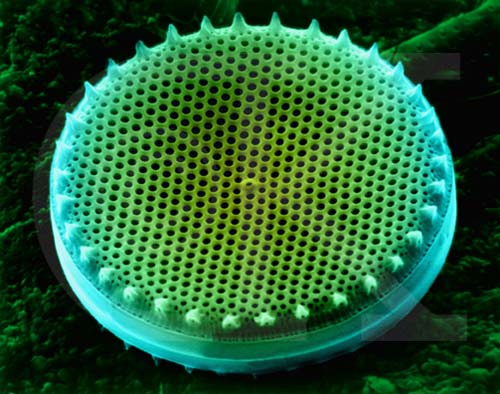Euglenoids (Phylum Euglenophyta) are free-living flagellated cells that live in freshwater. The majority are photosynthetic autotrophs, although some are heterotrophic and feed on dissolved organic compounds. We will discuss photosynthesis in more detail when we study plants. It is the synthesis of carbohydrates from carbon dioxide and water in chlorophyll containing tissues exposed to light.
Euglena, a typical euglenoid, is covered by a flexible pellicle and possesses a flagellum. It also has an eyespot to detect the sunlight necessary for its photosynthetic activities.
This animation (Audio - Important) describes the life cycle of the green algae Chlamydomonas.
Chrysophytes (Phylum Chrysophyta) are mainly free-living photosynthetic cells. There are four groups:
 Chrysophytes possess chlorophylls a and
b, but other pigments (fucoxanthin) mask it and give shades of yellow color to the algae. The
siliceous shells of
diatoms
are commercially valuable as abrasives (as in toothpaste) and filtering materials. Huge deposits of
these algae are found in places such as the white cliffs of Dover, England.
Chrysophytes possess chlorophylls a and
b, but other pigments (fucoxanthin) mask it and give shades of yellow color to the algae. The
siliceous shells of
diatoms
are commercially valuable as abrasives (as in toothpaste) and filtering materials. Huge deposits of
these algae are found in places such as the white cliffs of Dover, England.Dinoflagellates are marine photosynthetic cells that display flagella located in grooves of the cellulose covering. Some forms of red-pigmented cells cause the infamous red tides and also produce a neurotoxin fatal to humans. Others are bioluminescent making the ocean waves shimmer at night.
A dinoflagellate known as Pfiesteria piscicida attacks and destroys fish by the thousands in a few hours. The problem is most severe off the North Carolina coast where the water is enriched by the nutrient runoff from agricultural interests.
These algae are most abundant in tropical seas and possess phycobilin pigments, which can trap sunlight in deep marine waters.
The modes of reproduction are diverse, with complex asexual and sexual phases, but the multicelled stages do not have tissues or organs.
Some forms can aid in reef building (stonelike cell walls), others yield agar, and carrageenan that is used as a stabilizer in ice cream.
This animation (Audio - Important) describes the life cycle of a red algae that you may have eaten.
(Phylum Phaeophyta) This group is most abundant in temperate seas and includes the large kelps of the intertidal zones. Xanthophylls, fucoxanthin, chlorophylls (a and c), and other pigments provide the color.
They are very plantlike in structure with leaflike blades growing from a stemlike stipe, which may be attached to a rootlike holdfast. Some giant kelps have gas-filled bladders, or floats.
A substance produced in the cell walls (algin) is used as a thickening or suspension agent in foods.
(Phylum Chlorophyta) They grow virtually everywhere and bear the greatest resemblance to land plants of any of the algae.
They have the same pigments as land plants (chlorophylls a and b). They possess cellulose in the cell walls and store carbohydrates as starch.
Some are symbionts with fungi, protozoans, and a few marine animals. Others are colonial (Volvox), and many live singly (Chlamydomonas).
REVIEW: �The gritty substance you may feel on your teeth after using toothpaste is actually�
REVIEW: Red algae��
REVIEW: Holdfasts, gas-filled floats, and a thick leathery surface are found in species of��
REVIEW: �Most freshwater algae belong to which phylum?�
PREVIOUS
NEXT
LECTURE 14 INDEX
MAIN INDEX